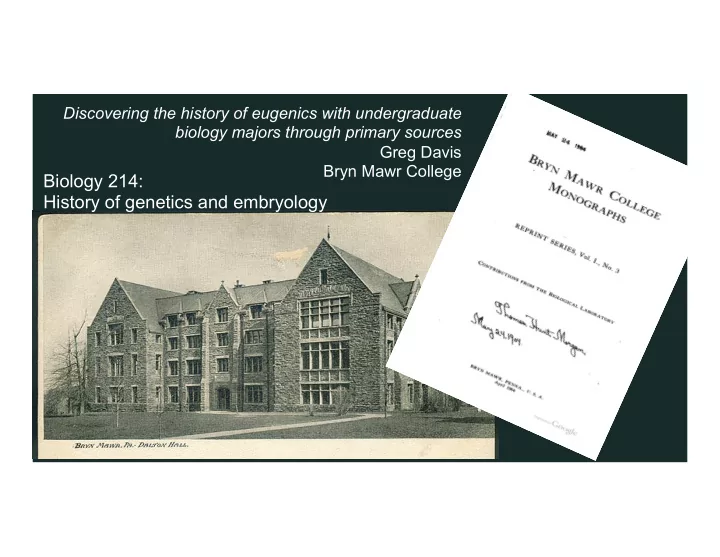

Discovering the history of eugenics with undergraduate biology majors through primary sources Greg Davis Bryn Mawr College Biology 214: History of genetics and embryology
Stevens to Davenport - May 10 th , 1910 I have been thinking for some time of making a move before long, either to work on the cytological side in cooperation with some one who is carrying on experimental work in Genetics, provided that I remain here; or to try to secure a position as cytologist in connection with work on Genetics. We have no opportunity here to carry on experiments in heredity... Please do not mention the fact that I have asked you this question as I do not wish it known at present that I am even considering a change. Nettie Stevens Davenport to Stevens – March 1 st , 1911 Bryn Mawr College 1903-1912 I have long wished that it might be possible for you to be more intimately associated with this Station and I should be glad to offer you the vacant position beginning the first of July or whenever it would suit your convenience. Charles Davenport Director of Cold Spring Harbor Laboratory Founder of the Eugenics Record Office
Students engage with primary literature by historical actors at Bryn Mawr College
American Museum of Natural History NYC, 1921 “[G]enetics is, therefore, the very foundation on which the superstructure of eugenics is being built...” “[T]the boundary between them [genetics and eugenics] is ill defined and movable...” Aims and Methods of Eugenical Societies Leonard Darwin (son of Charles) Talks by eugenicists Talks by geneticists • Harmonic and Disharmonic Race Crossings • Darwinian Evolution by Mutation • Some Results of Race Mixture in Hawaii • Inheritance in Unicellular Organisms • Intermarriage between Jews and Christians • A Simple Explanation of the Heredity Mechanism • Eugenic Problems of the Slavic Race • Sex Determination in Rotifers • The Inheritance of Eye Defects
Is Inbreeding Injurious? “[inbreeding] invariably brings to light the latent characteristics that were hidden by outbreeding: it cannot, from its very nature, introduce any new characters into the stock...if only the superior individuals are allowed to breed, the unwanted traits in the stock can be eliminated.” “[if] the same congenital defect or undesirable trait Image courtesy of Wistar Institute does not appear in the three previous generations of Helen Dean King two cousins … there is no more danger that the Bryn Mawr College PhD 1899 offspring of such marriages will be defective than Wistar Institute beginning 1908 there is danger of the appearance of defective children in any family.” Inbreeding is ultimately good because it can accentuate desirable traits and reveal undesirable recessive traits that can then be selected against
Co-discovering/co-learning the history of eugenics with biology students using the primary literature Advantages • Student in the role of co-discoverer rather than recipient • Can be fun and exciting for both the instructor and student • Discovering the unexpected can help students appreciate nuance Not knowing exactly what you will find, however, does come with some risk of misinterpretation on the part of the student (e.g., being persuaded by rhetoric of the time period, or taking a quote out of context). • Works better in small groups wherein you can work closely with each student. • Secondary sources are also an important support.
Students whose work in Biol 214 was referenced • Marcia Manzone (Spring 2016) • Stephanie Yong (Spring 2018) • Emma Ecker (Spring 2019) Primary Sources • Darwin, Leonard (1923) Aims and Methods of Eugenical Societies in Eugenics, Genetics, and the Family: Scientific Papers of the Second International Congress of Eugenics. Vol. I, Williams & Wilkins. • King, Helen Dean (1921) Is Inbreeding Injurious? in Eugenics, Genetics and the Family: Scientific Papers of the Second International Congress of Eugenics, Vol. I, Williams & Wilkins. Secondary Sources • Clause, BT(1993) The Wistar rat as a right choice: establishing mammalian standards and the ideal of a standardized mammal J Hist Biol 26. • Richmond, M (2007) Opportunities for Women in Early Genetics Nat Rev Genet 8. • Ogilvie, MB (2007) Inbreeding, Eugenics, and Helen Dean King J Hist Biol 40.
Recommend
More recommend